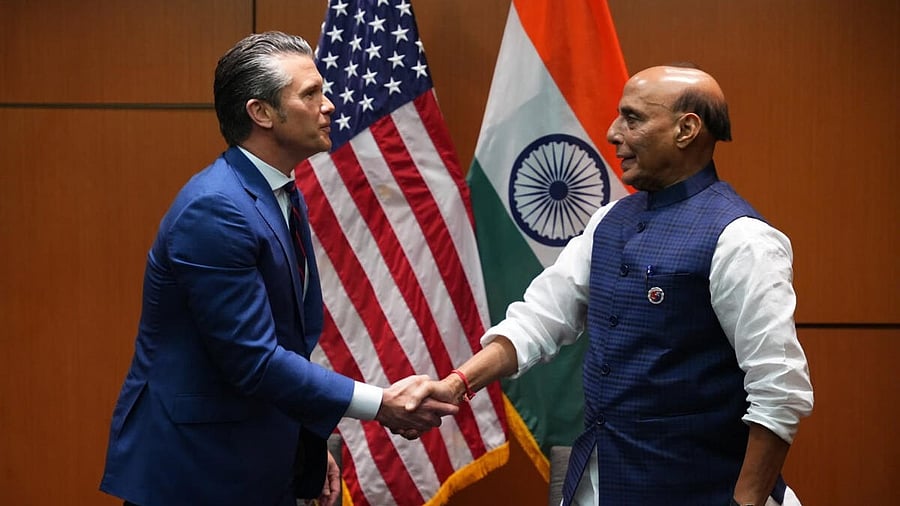
Defence Minister Rajnath Singh with United States Secretary of War Pete Hegseth during a meeting to sign a 10-year U.S.-India Defence Framework, in Kuala Lumpur, Malaysia.
Credit: PTI Photo
The 10-year ‘Framework for the US-India Major Defence Partnership’ is one of those instances where the contents of a covenant are less important than its circumstances and its ambience.
Inking of this framework was important for the United States Secretary of War, Pete Hegseth, whose nine-month tenure has little to show. The shoes he has stepped into were previously worn by distinguished Americans who excelled in intellectual brilliance or had extensive political experience. No one of any eminence in the US has yet claimed that Hegseth has either.
The meeting between Hegseth and Defence Minister Rajnath Singh on October 31 on the sidelines of the 12th ASEAN Defence Ministers’ Meeting-Plus (ADMM+) in Kuala Lumpur was, therefore, tailor-made for Singh to get the better of his US counterpart. However, this required subtleties of the kind which characterised 14 rounds of talks over two years on three continents between one of Singh’s predecessors, Jaswant Singh, and US Deputy Secretary of State Strobe Talbott in the wake of India’s nuclear tests in May 1998. India acquitted itself creditably during these talks, according to Talbott’s book, Engaging India, which is an account of these meetings. They ended half a century of estrangement between India and the US.
Singh’s meeting with Hegseth, leading to the defence partnership, should have been part of a larger framework of reworking India-US relations, now at its lowest point in the new millennium. India held all the aces when the Defence Minister went into the Kuala Lumpur meeting. But he did not use them, presumably because he did not have the political clearance to do so.
By a consensus on New Delhi’s grapevine, there was concern at the highest political levels about further annoying US President Donald Trump, who could have unleashed another diatribe against India if it quibbled with Hegseth instead of simply signing the defence framework. The spin in the Indian media led to descriptions of what the two Ministers signed as ‘historic’. It is anything but that.
The 2025 ‘Framework for the US-India Major Defence Partnership’ is little more than the ‘New Framework for the US-India Defence Relationship’, which then Defence Minister Pranab Mukherjee signed with his US counterpart Donald Rumsfeld in June 2005. It was also for 10 years, and was extended by another decade until the latest signatures in Kuala Lumpur.
What Mukherjee signed opened a new era in bilateral defence engagement. It led to modest arms sales by US companies to India — one of the first big deals was a one-billion-dollar sale of Hercules military planes to India by the George W Bush administration in its final year in office.
The critical aspect to consider about the up-to-date defence partnership is what India should have done. New Delhi should not have insulated defence from the overall bilateral relationship and routinely renewed what Mukherjee and Rumsfeld signed, with periodic updates and changes, of course. It should have made signing the latest framework conditional on a trade agreement and a negotiated compromise on tariffs.
India had the leverage. India is the world’s second-biggest arms buyer, according to a study by the Stockholm International Peace Research Institute, published in March. When US military production jobs are dependent on overseas orders, arms buyers have the leverage. Russia, France, and Israel have been the three biggest weapons suppliers to India for many years. The US wants to wean India away from these suppliers towards US arms. India did not use this leverage or ask for a reduction in tariffs as a quid pro quo.
On August 8, when Trump was ranting against India on the ceasefire with Pakistan and calling New Delhi the “world’s tariff king”, the government’s spin masters in the capital’s Shastri Bhavan office complex are said to have leaked a story to Reuters that India has “paused” new arms purchases from the US. The leaked story also said Rajnath Singh had ‘cancelled’ his planned visit to Washington. The same day, the Ministry of Defence said the news item was “false and fabricated”. The leak was believed to have been a trial balloon to gauge Trump’s reaction to any rupture in India-US defence ties. Trump did not care. He did not react.
According to high-level sources involved in all-around negotiations with the US, an inter-ministerial debate ensued in New Delhi. Those who argued that stepped-up defence relations would incentivise the Trump administration and should not be intertwined with tariff talks won out. It was a mistake.
India must not underestimate its strengths. Riskier is the prospect that under the latest defence framework, India would be buying low-grade technological military equipment from the US. Its laws do not allow sales to New Delhi that are equal to what are offered to Washington’s treaty allies.
K P Nayar has extensively covered West Asia and reported from Washington as a foreign correspondent for 15 years.
(Disclaimer: The views expressed above are the author's own. They do not necessarily reflect the views of DH.)